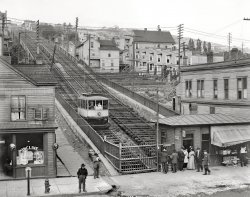
MAY CONTAIN NUTS

Search Shorpy
SHORPY ART

Framed or unframed, desk size to sofa size, printed by us in Arizona and Alabama since 2007. Explore now.
Join and Share
Ad-Free Shorpy
Shorpy is funded by you. Patreon contributors get an ad-free experience.
Learn more.

Recent comments
- Hudson’s Big Store
- Say what??
- Grapes?!
- A Beautiful Moment
- Such joy
- Bethune-Cookman University today...
- Yellow sky at morning
- Side Winder
- Air Quality?
- Sojourner Truth riot
- None were so blind(ed)
- The less famous sister
- Good ol' days?
- Rise and Fall
- Goo Goo Ga Joob
- Ticket Retention
- Not the only one
- Vagaries of War
- Killed by Amtrak
- Back to the Future
- Wanted --
- If you can't stand the light
- Centralized Traffic Control, I believe
- What's really happening
- Heckuva remote control!
- Sometimes — Things Go Bump!
- I SEE THE LIGHT
- Union Switch and Signal Company
- Get That Light Out Of My Eyes
- Eggs. Eggs. Eggs. The Egg Man is Here!
Member Photos
The Shorpy
Print Emporium
Print Emporium
Search Shorpy
Search results -- 30 results per page
- Old Iron Sides: 1907
- Circa 1907. "Cincinnati -- Mount Adams across Ohio River from Covington, Kentucky." With a ... I'd love to know.
(The Gallery, Boats & Bridges, Cincinnati Photos, DPC) ... Posted by Dave - 01/17/2016 - 12:50am -
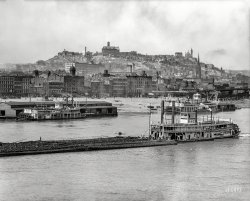
- Thurston the Great: 1915
- ... (1869-1936), the "King of Cards." Strobridge Lithography, Cincinnati & New York. View full size.
Thurston's Cafe ... Posted by Dave - 11/28/2007 - 2:49pm -
![Thurston the Great: 1915 The spirits do come back, if you stay for the second show. 1915 poster advertising an appearance by the magician Howard Thurston (1869-1936), the "King of Cards." Strobridge Lithography, Cincinnati & New York. View full size.
Thurston's CafeThere is a very cool breakfast/lunch cafe in Calhoun, Georgia dedicated to Thurston the Magician. This poster, and many, many others decorate the walls, and the bouquets at each table appear to be popping out of a magic wand. They serve great homemade desserts, sandwiches and coffee drinks, and the building has exposed brick walls, the original wooden floors and lots of charm.
Thurston the GreatI am Kassidy Thurston, a descendant of Thurston the Great, and am doing a presentation on him for my third-grade class. If anyone has information that may be able to help me out with this project I would really appreciate it. Thank you very much,
Kassidy Thurston
P.S. any information can be sent to my mom at kim_thurston@yahoo.com
[There are lots of articles about him the the New York Times archive at nytimes.com. Just search for "Howard Thurston." There's an item about him hypnotizing a goose. - Dave]
Howard Thurston the GreatHi my name is Michelle Thurston and I am a descendant also. He was my great-great-uncle on my father's side. My dad is Frank E. Thurston Jr. I have a magic book of Howard Thurstons. I am 42 years old and have six children. Good luck on your report. We must be related in some way.
Sincerely
Michelle Thurston Morton
Thurston the Great-GrandsonI just recently found out that I am the great-grandson of Thurston the Great. I was born in West Virginia and I have some basic information. My father is still alive and knew of Thurston but only as a young boy (Dadr was born in 1924). Thurston had two sons and five daughters according to my family tree.
Feel free to contact me at thereisnospoon AT charter.net (remove the AT and put in the @ )
Larry Thomas
How he helped the 1907 CubsThurston is covered quite extensively in the book The Greatest Team Ever. There are even depictions of two of his shows.
He was a popular man My dad, Frank A. Thurston, said that Howard is my great-great-uncle as well, I think he had a lot of groupies. Most of the magic today is his patents. He had 13 train boxcars of tools of his trade. His daughter died in San Diego several years ago.
Thurston the Great-GrandsonJust to let you know, Howard Thurston the magician had no biological children but adopted Jane as his daughter when he married her mother when she was 5. I am his great-great-great niece; he was my grandpa's grandpa's brother.
I might be related........I came across this site while looking up my biological grandfather, Frank A. Thurston. My biological father was Charles Thurston, a.k.a. Chucky. My brother and I were put into foster care back in the early 80's. Any info regarding my biological family would be great. I have led a very interesting life and would like to know a little more about my bloodlines.
(The Gallery, Magic & Spiritualism, Posters)](https://www.shorpy.com/files/images/1666u.thumbnail.jpg)
- Falls City: 1900
- ... Falls City. This appears to be the last, built in 1898 at Cincinnati. 132 feet long, owned by the Louisville & Kentucky River Packet ... Those occupations haven't vanished, Anon. As a Cincinnati-based musician, I've worked enough riverboat gigs that the romance ... Posted by Dave - 07/20/2012 - 7:14pm -
![Falls City: 1900 Vicksburg, Mississippi, circa 1900. "The levee." And the sternwheeler Falls City. Dry plate glass negative, Detroit Publishing Company. View full size.
Point & shootCameras back then were bulky and required time to set up. Nowadays this shot could be taken while walking past the scene. While the photographer didn't try to make this shot "casual", it has that look about it.
Because of this, we see a more accurate glimpse of what life was like then. The detritus in the water, the men (only men in this scene) waiting for business and/or passengers, the six or seven ships in the background all show a thriving economy.
PerfectA stage set for "Showboat"! I can hear "Old Man River" just as plain as day! Thanks. Look! There's Howard Keel!
Falls City, my home townAlthough there are towns with this name in Nebraska and Oregon, the Falls City name likely refers to Louisville, which owes its existence to the Falls of the Ohio River. The late lamented Falls City Beer was brewed in Louisville starting in 1905.
From the signage it appears that in 1900 this sternwheeler was working the Mississippi between Vicksburg and Greenville. It had come down in the world, literally.
Falls City factsAccording to Way's Packet Directory, there were five boats named Falls City. This appears to be the last, built in 1898 at Cincinnati. 132 feet long, owned by the Louisville & Kentucky River Packet Co. The book notes that the boat was not taken to Vicksburg until 1908, but it was common practice for boats to "tramp" when work was slow in their home trade.
Photo capabilities in 1900?What intrigues me most about this shot is how well motion has been stopped. The horses’ movement and even the water flow from boat to river. Most photos from this era seem to blur anything with the slightest motion. What were the capabilities for shutter speed given the emulsions of the time? Just lucky to have an extremely bright day?
[By 1900, exposure times for outdoor photography on a sunny day would be measured in fractions of a second. - Dave]
Vanished OccupationsTwo jobs I would have loved to have, but are forever unavailable: (a) Paddlewheel Riverboat Pilot; (b) bandsman on the nicer passenger boats. Lot of the groundwork for early jazz got laid down on those boats.
Cost of a steamboat tripI imagine that the cost of taking the Falls City from Vicksburg to Greenville was incredibly cheap as by 1900 the Illinois Central ran multiple trains a day on their Yazoo and Mississippi Valley Railroad between Memphis, Leland, Vicksburg, Natchez and Baton Rouge. At Leland, the Southern Railway of Mississippi could take a passenger 15 miles west to Greenville. Does anyone know riverboat fares from 109 years ago?
Per some of my Gulf & Ship Island Railway documents from 1902, it cost $1.25 to travel from Jackson to Hattiesburg, a distance of 95 miles, and I imagine that in those highly regulated days the fare for the journey between two cities of similar distance would be similar. I should have been a historian.
Re: Vanished OccupationsThose occupations haven't vanished, Anon. As a Cincinnati-based musician, I've worked enough riverboat gigs that the romance has faded, and my first thought is always what a PITA it is to haul equipment down to the docks. Most American river cities have at least a few excursion boats working the river, and all those boats have pilots (although, sadly, you're more likely to hear recorded music these days). I've had a few conversations with riverboat pilots, and they're a really interesting bunch.
Steam has been mostly replaced by diesel, and the paddlewheel is more than likely decorative, but those jobs are still out there. And those riverboats where the sounds of jazz were first heard? They were primarily excursion boats, just like today.
At first glancethis scene could as easily be 1850 instead of 1900. Until I looked at the gent sitting on the barrel center front, his clothes give him away as "not 1850."
Tickets please.Could not find pricing for Vicksburg to Greenville, but comparable short trips in Mississippi and Louisiana were about $8 for a cabin, and $1 to $2 for deck passage.
SteamboatsChautauqua Lake in western New York State had, like most comparable bodies of water in that era, an extensive fleet of large steamboats. The Lake steamers were all (except one) screw driven, with deeper drafts. But otherwise they were very similar to this.
The last Chautauqua steamer was the City of Jamestown, about 110 feet long with two decks. It ran frequent excursions though the 1950s.
I vividly remember it pulling into the pier in 1951 or 52, belching steam. I never ran so hard in my life as when I ran down to the water to see that magnificent vessel. My own personal little Mark Twain memory.
Make that 3 decks. http://cchsnys.org/mp/mp_chautauqua_lake_steamboats_4_08/acoj.html
Sharp lookerWhat a gloriously rich image. The detail cries out to be examined further. Thanks for posting it!
(The Gallery, Boats & Bridges, DPC, Vicksburg)](https://www.shorpy.com/files/images/4a24850u.thumbnail.jpg)
- Primitive Ferry: 1907
- ... the Shaker Ferry, as seen in this photo from the Cincinnati Public Library collection.
Valley View Ferry Might this be ... Posted by Dave - 08/21/2012 - 7:50pm -
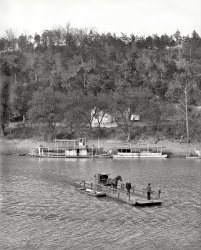
- Lying-In Hospital: 1908
- ... Gamble, son of the co-founder of Proctor & Gamble in Cincinnati. I am a docent there and tour visitors always remark about the low ... Posted by Dave - 09/13/2011 - 11:37am -
![Lying-In Hospital: 1908 New York circa 1908. "Lying-In Hospital, Second Avenue." A peek behind the scenes at the Lying-In (or maternity) hospital, which in addition to scalpels had a number of cutting-edge medical devices. 8x10 glass negative. View full size.
High techAt least there's plenty of light -- boy, is there plenty of light. How many bulbs are in that fixture? It looks like about twenty-five.
(But that, um, irrigation device scares me.)
Sketchy Sanitation I am stunned that the bandages she is rolling appear to all have been on the floor at some point.
Now Weill CornellTwo of my children were born there. Modes of childbirth have changed enormously since 1908. Today, there is a sharp division between those getting Caesarian sections, who experience NASA-like technology in a setting reminiscent of the one in this photo, and those having "natural" childbirth, for whom lots of monitors and beeping devices are provided, but in a setting that is much softer.
TP Gone BadCan someone explain the tissue on the floor? Is she a nurse or a baker? It looks like she is carefully rolling the tissue up from off the floor in flour. With the park bench seating, this room makes me uncomfortable.
Oh, I get it... got one in the oven?Great joke! She's actually making cannoli at the table (all the flour was a give-away) and he's about to fill the injector with ricotta cheese. Once I saw the cheesecake pan with an EZ-fill chute, on the lower shelf to his right, I knew. They've got some cleverly designed baking devices there.
NothingThere is absolutely nothing in this room that gives me comfort nor confidence. Had I been of birthing age, I think I would have remained the spinster aunt.
You look a little flushed..Just be glad that irrigation device is gravity fed and not hooked to a pressure pump.YEOW
Rutherford EstatesThe building at 17th street and Second avenue is now a condominium called Rutherford Estates at Stuyvesant Square. There is a plaque on the front that says that in 1902, 60 percent of the Manhattan children who were born in hospitals were birthed at Lying In.
Plaster of ParisCould she be putting dry plaster of Paris on those strips in order to later make casts from the soaked rolls?
Ick.Sterile floors make sterile bandages. Doh!
Another Shorpy Lesson LearnedI was born (many) decades ago at Massachusetts Lying-In. I just learned this morning that the Lying-In part meant maternity.
Thanks but no thanksTalk abut sanitation! No wonder so many women had their babies at home.
Electric RaysThe Gamble House in Pasadena, CA is a historical house commissioned in 1908 [the year of this photo] as a winter residence by David Gamble, son of the co-founder of Proctor & Gamble in Cincinnati. I am a docent there and tour visitors always remark about the low lighting intensity throughout the house. [Brief editorial ahem -- Procter, not Proctor.]
Although Edison's incandescent lamp predated the house by almost 30 years, there remained concern about the long-term negative effects of the eye's exposure to the so-called "electric rays." Clear glass bulbs - rated at a blazing 15 watts - are enclosed by frosted glass or by a beautiful, custom-designed art glass chandelier or sconce. That is, except in the kitchen - a staff area where the residents rarely ventured - where the same bulbs are unshielded and in direct view.
The first rule of rolling bandages1. Make sure you throw the bandages on the floor before rolling them to ensure they stay sanitary !
Heat and ServeAll of these bandages will probably be popped into the autoclave to be sterilized -- but I'd still feel better if they hadn't started out on the floor.
Roll Your OwnIs that nurse rolling bandages from a pile of bandage stock on the floor? It looks like her hands and the floor have powder on them. Maybe it's sterilizing powder.
(The Gallery, D.C., G.G. Bain, Medicine)](https://www.shorpy.com/files/images/01362u.thumbnail.jpg)
- Wurlitzer: 1910
- Cincinnati, Ohio, circa 1910. "Fourth Street east from Race Street." 8x10 inch ... on it. Wurlitzer's original company headquarters was in Cincinnati, but the building burned in December 1904. Its replacement at 121 ... ground return through the tracks (DC current). What made Cincinnati interesting is that it was one of very few cities where the ... Posted by Dave - 07/29/2012 - 2:42pm -
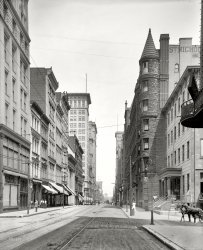
- Mercantile Library: 1910
- Cincinnati circa 1910. "Mercantile Library Building, Walnut Street." Note ... in the United States. - Dave]
(The Gallery, Cincinnati Photos, Detroit Photos, DPC, Streetcars) ... Posted by Dave - 07/31/2012 - 2:55pm -
![Mercantile Library: 1910 Cincinnati circa 1910. "Mercantile Library Building, Walnut Street." Note plants and bottle on the sills of Dr. Ellen M. Kirk. A year ago we saw the other end of this block here. 8x10 glass negative, Detroit Publishing Co. View full size.
LetterboxOn a post towards the corner. You used to see these everywhere. Another piece of vanished Americana. Ask anyone under the age of 30 what a "letterbox" is, and they'll tell you "a DVD/DVR function".
AdditionThe top two floors of the building next door to the Mercantile seem to have been plopped on. They don't seem to have any common details with the lower portion except for window spacing. I wonder when that was done.
[The Traction Building was completed in 1902. The top and bottom floors are clad in sandstone, with red brick in between. - Dave]
And above Dr. Kirk's sillsThere's a person in the window.
Dixie TerminalThe Mercantile building is still there although I've never seen it fully occupied.
This photo looks as if it was taken from midway up the Dixie Terminal, the old bus terminus (where the "bank" scenes were shot for Rain Main). I worked in that building until May of this year.
Tripartite Facade CompositionThe top two floors are definitely part of the original design of the Traction Building. The street facades of this building (and that of the Mercantile Library as well) follow the then-popular skyscraper facade formula of base, middle section, and top. In the architectural theory of the day, this was considered analogous to a classical column, which a has a base (bottom), a shaft (middle), and a capital (top). The most prominent exponent of this idea was Louis Sullivan, who described it at great length in his 1896 article for Lippincott's Magazine, "The Tall Office Building Artistically Considered." Sullivan gave many examples, most drawn from nature, of compositions with three parts, including the classical column. It was from the pairing of different building functions with each of the three parts of the facade design that Sullivan derived his famous slogan: "Form follows function."
Mercantile Library?We can count on Shorpy to see if we're paying attention. Small-town boy that I am, I'd never encountered a "mercantile" library, so I had to look it up. It was named in honor of the 45 merchants and clerks who founded it, not for its contents.
Perilous timesIn viewing these vintage photos I often think how perilous even routine jobs were back then. Today we have bucket trucks that let workers reach high places safely but pity the poor guy who had to replace the light bulbs in that "GIBSON" sign cantilevered out seven floors above the street.
The distinguished Dr. KirkDr. Ellen M. Kirk was a homeopathic physician and co-founder in 1879 of what became the Ohio Hospital for Women and Children. Received her M.D. in 1877 from the New York Medical College and Hospital for Women. Professionally active, she published research, primarily in obstetrics. Died in 1935.
The 10,000-Year LeaseThe building still stand but more importantly perhaps is the fact that the Mercantile Library, founded in 1835, still flourishes and occupies the entire 11th floor and part of the 12th floor under a 10,000-year lease.
Just to the right of the main entrance you can see a sign advertising "Cigars." Amazingly enough, the space today is occupied by tobacconists, maybe the same tobacconists -- Straus.
4th Floor ShingleSpeaking of Doctor Kirk -- the sign appears to give the good doctor the first name of Ellen. That suggests that either Ellen M Kirk was a rare (for 1910) female doctor, or Ellen's parents gave their son a "boy named Sue" style name.
[Scroll down for more on Dr. Kirk. In 1910 there were more than 7,000 practicing female physicians in the United States. - Dave]
(The Gallery, Cincinnati Photos, Detroit Photos, DPC, Streetcars)](https://www.shorpy.com/files/images/4a22277a.thumbnail.jpg)
- Island Queen: 1907
- ... Bridge on the Ohio River between Covington, Kentucky, and Cincinnati in 1907. View full size. Detroit Publishing Co.
If this ... August of 2008 looking north across the Ohio River toward Cincinnati from Covington, Kentucky.
(The Gallery, Boats & Bridges, ... Posted by Dave - 07/29/2012 - 2:39pm -
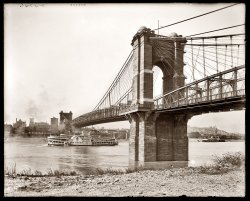
- Caught Wet-Handed: 1904
- ... 1904. "Tyler Davidson Fountain ('The Genius of Water'), Cincinnati, O." 8x10 inch dry plate glass negative, Detroit Photographic ... Mabley & Carew was a longtime department store in Cincinnati. It, and all the buildings in the photograph, are long-gone.
... Posted by Dave - 07/22/2018 - 10:54am -
![Caught Wet-Handed: 1904 1904. "Tyler Davidson Fountain ('The Genius of Water'), Cincinnati, O." 8x10 inch dry plate glass negative, Detroit Photographic Company. View full size.
Slip and Fall accidents can be painfulNo amount of money could make me do this.
Fascinating Fountain Facts... may be found here:
http://www.cincinnatimagazine.com/columns/17-facts-tyler-davidson-founta...
School of --Proctology?
[No wonder you couldn't fix my record player. - Dave]
Pretty neat viewFound a really nice 360 of the fountain square.
https://goo.gl/maps/vvXWDKKwVkr
Soggy telegramsHopefully the two messenger boys had made their deliveries for the day.
WKRPAs seen in the opening credits of the TV show WKRP.
That really is watercoming from her hands -- isn't it?
[Hence the title. - Dave]
Still thereThe fountain is still there, although it's been moved around 40 feet to the right. Fountain Square, where the fountain sits, is still a popular gathering place downtown. Mabley & Carew was a longtime department store in Cincinnati. It, and all the buildings in the photograph, are long-gone.
Going Your Way?
You can catch the Cincinnati, Hamilton & Dayton (CH&D) to Chicago right here and have the porter bring you bottles of whatever.
If you are interested in the history of the CH&D, there is a book "The Pere Marquette Railroad Company" written by Dr. Paul Wesley Ivey. He states in chapter 7 of dealings with the infamous J.P. Morgan, the Erie railroad, the PM and the CH&D. Of course when ya get to the end you find out the robber barrons did it!
This is pre B&O. Later it became the Toledo Division of the B&O.
(The Gallery, Cincinnati Photos, DPC, Streetcars)](https://www.shorpy.com/files/images/SHORPY-4a11624a.thumbnail.jpg)
- Royal Spartanette: 1952
- ... 1952 Spartan 27-foot Tandem for six months after a move to Cincinnati, the winter of 2009-10. It was parked inside a garage, fully ... Posted by Dave - 01/29/2014 - 5:22pm -
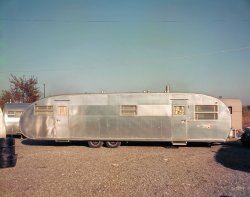
- Looking Down: 1905
- ... and I just assumed it was unique. Certainly there, or in Cincinnati, it served a practical need, but I find it striking the number that ... Posted by Dave - 07/29/2012 - 1:32pm -
![Looking Down: 1905 Dutchess County, New York, circa 1905. "Mount Beacon Incline Railway, looking down, Fishkill-on-the-Hudson." 8x10 inch glass negative. View full size.
Max Elev.Immediately brought to mind "High Tor" by Maxwell Anderson.
Signal wiresI noted the left pair of wires suspended under the brackets on the poles. I worked in a coal mine for a while in Colorado, which was on a steep slope and had a similar inclined track, but underground. The "conductor," if you will, had a long wooden stick with a metal bar mounted across one end. He could signal the hoist operator on the surface from any point in the incline by basically shorting out the two wires above us, which rang a large gong signal in the hoistman's cab. Basic signals were one bell to stop, two to go up, three bells to go down.
[Or would he be closing the circuit rather than shorting it. - Dave]
Dave: You are correct ......
Get your lean on!Look how far forward that fellow in the front is leaning. Really puts the grade of incline in perspective.
The OtisThe two towns below were Matteawn and Fishkill Landing, incorporated into the city of Beacon in 1913. This was one of two great "Otis Inclines" built in the Hudson Valley by the elevator maker. The other served the Catskill Mountain House from the Palenville rail connection to the steamboat landing at Catskill.
Great place to hikeThe incline railroad was active from 1902 to 1978. The land is now preserved as Mount Beacon Park. Hikers up for a strenuous workout can climb a staircase and then huff and puff up an eroded woods road to the top.
There is talk about rebuilding the railroad. For now, only the shell of the powerhouse remains. Great views are still available from the top:
Acrophobics AnonymousAnyone have their number?
Gone but not forgotten.Seems to have been completely destroyed by a fire in 1983 but there is interest in it still.
http://www.inclinerailway.org/index.html
The Secret Of Its SuccessThis railroad was a hit with its passengers because they were so inclined.
Take a ride down Memory LaneIn this video clip.
Name ChangeThe former Fishkill-on-the-Hudson is Now Beacon. There is still a Fishkill, but it's a mile or so to the east.
PriviesLove the outhouses!
I think I'm spotting a trendI'm amazed at the popularity of incline railways at the turn of the 20th Century. Growing up in Southern California, we always heard about the long-dismantled Angel's Flight, and I just assumed it was unique. Certainly there, or in Cincinnati, it served a practical need, but I find it striking the number that were constructed for pleasure purposes, as this one clearly was. Hard to imagine such a capital investment today.
From across the riverI was born and raised in Newburgh, just across the river from Beacon, and recall as a kid, hiking up Mount Beacon at least twice. Those excursions involved a bus ride from my house down to the ferry terminal, the ferry ride over to Beacon, and a long walk up through Beacon to the cog railway terminus at the foot of the hill, and then trudging up the mountain to the top. A long journey, but well worth every step!
I am illuminatedDon't miss rjc's video clip below. That answered some questions for me. I was looking for the second track and had forgotten how that could work with a counterbalance car. Also, check out the guy following the car down the mountain. It looks like he is riding a device that lets him coast down the hill on either one rail or the outside wooden one. I can't tell which one he is on.
(The Gallery, DPC, Railroads)](https://www.shorpy.com/files/images/4a17154a.thumbnail.jpg)
- Dr. Bliss: 1920
- ... 'F' DIATHERAPY MACHINE
from The Liebel-Flarsheim Co., Cincinnati, Ohio
I like the plate that says "Atomic force for physicians use" ... Posted by Dave - 09/13/2011 - 11:30pm -
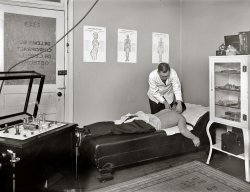
- Frankenstein Jeweler: 1907
- Cincinnati circa 1907. "Fifth Street north from Race." Golden age of the ... changed since this photo was taken .
(The Gallery, Cincinnati Photos, DPC, Stores & Markets, Streetcars) ... Posted by Dave - 12/26/2015 - 2:27pm -
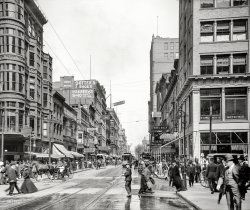
- High Bridge Depot: 1907
- ... the other reads "CHA 234.8." Thanks.
[Distances to Cincinnati, Ohio and Chattanooga, Tennessee.]
Pedestrians Welcome? ... Posted by Dave - 02/06/2012 - 4:14pm -
![High Bridge Depot: 1907 Circa 1907. "High Bridge station, High Bridge, Kentucky." 8x10 inch dry plate glass negative, Detroit Publishing Company. View full size.
The spur best not takenDon't think I want to be switched onto that spur to the left. I wonder if there was originally an incline to move materials up the mountain?
High on High BridgeOne of the barely remembered memories I have of University of Kentucky college life in the early 70s was walking out on High Bridge at night while, well, pretty darn high. Apparently, this was a popular stunt. Four or five of us thought this would be a good idea at the time. Until the train lights and whistle kicked in.
Thanks to Shorpy for getting me thinking of how a God knows how many car freight train blowing past you at night and close enough to reach out and touch feels like from the late winter of early 1973.
Mr. White HatJust had a brilliant idea.
Never Saw This BeforeIf you go to High Bridge, KY on Google Earth, there is a full three dimensional rendition of the present-day bridge. No station, though.
Signal smorgasbordA train crew would have to be alert to the various signals on display here. On the depot, above the bay window are the signals that alert the crew that train orders from the dispatcher need to be received. Across the tracks between the depot and turnout is a block signal that informs a train crew about what is ahead of them, or possibly informs them if they are to take siding here. And just to the right of the bridge is a Ball type of signal that may be part of the regular block signal system or one that assures the train crew that all is well on the bridge, or it is one that stops all trains if activated by a maintenance crew that would have work to perform on the bridge.
Why the NameBuilt to cross Stating the Obvious Creek.
Stay behind the yellow line!As an Amtrak agent for 23 years, I can say with certainty that standing as close to the track as possible while a train approaches is an obsession with the public. I've had several hundred people standing on a platform while a train was bearing down, all pressing each other as close to the tracks as they could. It scares employees to death, especially engineers. They would not be able to stop if someone fell off the curb, and then everybody would get to see how sausage is made. You just hope and pray that if it ever happens, it won't be a child.
The towersAs you might have guessed, originally this was planned to be a Roebling suspension bridge. But that project got cancelled by the Civil War. (And that's probably a good thing, since I don't think suspension bridges of that era were very good for railroads.)
[More here.]
High Bridge SignWhat are the two numbers on the sides of the High Bridge sign? One reads "CIN 100.3" and the other reads "CHA 234.8." Thanks.
[Distances to Cincinnati, Ohio and Chattanooga, Tennessee.]
Pedestrians Welcome?There's a gent who appears to be heading onto the span. If not a RR employee, I wonder if the bridge was open to pedestrians to cross. My gut tells me the RR wouldn't allow it, but the deck seems wider than need be, and could those be pedestrian hand ropes on the left edge?
Re: Pedestrians WelcomeIt wasn't unheard of for pedestrians to legally cross on railroad bridges. If there wasn't a nearby road or footbridge then the railroad would allow it. They'd often provide a walkway alongside the tracks for this purpose. In fact in some they still do. The CPR bridge here in Saskatoon has a pedestrian walkway that's used by university students to cross the South Saskatchewan River. It was designed for that purpose back in 1909.
Re: Signal smorgasbordThe white signal posing as Mr. Hat's brilliant idea is in fact a Hall or Banjo signal. Another can be seen on the other end of the bridge. Most likely this is part of a block signal system or possibly a block protecting only the bridge. The signal to the left appears to be part of an interlocking plant, rods for the switch and a point lock can be seen to the left. And of course the signal on the station is in fact a train order signal. The mishmash of train control here is great and typical of the time.
Two namesThis station has two names. When the agent communicates with the dispatcher or other stations using Morse or voice, his station name is "KR". KR would also be used on train orders, clearance cards, and anything else affecting train movements.
What's that short post with the number 103.2 on it? A mile post with a cross arm and insulators on it?
(The Gallery, Boats & Bridges, DPC, Railroads)](https://www.shorpy.com/files/images/SHORPY_4a13855a.thumbnail.jpg)
- The Sultan's Palace: 1937
- ... unique was actually made in the industrial North, mostly Cincinnati. Then it was floated down the Ohio River to the Mississippi River ... Posted by Dave - 08/03/2012 - 4:05pm -
![The Sultan's Palace: 1937 New Orleans, 1937. "Le Pretre Mansion, 716 Dauphine Street, built 1835-6. Joseph Saba house. Also called House of the Turk." As well as the Sultan's Palace. 8x10 inch acetate negative by Frances Benjamin Johnston. View full size.
Iron LaceThere is nothing more iconically New Orleans than lacy ironwork balconies and long shuttered windows. I'm so in love with this image!
Does anyone know if this building still exists? I'm from Oregon, but I've always loved New Orleans and will be back soon to visit. I'd love to put this gem on my list of places to see if it's there!
One last question - is it because of potential flooding that the home appears to be built one story above the street entry level? Do those lower floors get used at all, or are they essentially a basement?
IntoxicatingAnyone who has spent time in New Orleans knows there is no other place quite like it. It creates an atmosphere that is almost mind-altering, with the close, sultry, earthy air (no air conditioning in those days) and the curious, intimate stillness that occasionally occurs as in this photo, streets deserted with no signs of life except a bit of trash lying in the gutter. Where is everybody? They are inside and there lies the inspiration for the imagination. Especially intriguing are the rooms behind the real, fully functional shutters, open to air, closed to rain. Are the people within just trying to stay cool with overhead fans, are they cooking spicy, savory red beans and rice, are they making crazy love, sipping sweet tea and sampling pralines, listening to Louis Armstrong on the Victrola? I am transported back there by this so-accurate portrayal of a New Orleans street to where I can smell the smells and feel the surrounding humanity close, but unseen. Thank you Shorpy. As we know, you can leave New Orleans but New Orleans NEVER leaves you.
Nice words, OTYYou've captured so beautifully what makes New Orleans unique. It is one of the world's great cities "with a feel" that you just can't and won't find anywhere else. I've been there half a dozen times or so, and every time I visit that curious intimate stillness you speak of strikes me.
Harem of HorrorI've spent many a night in this house but I never heard the thump of heads of the Sultan's harem rolling down the stairs ... just the thump of tipsy neighbors falling up the stairs!
http://www.nola.com/haunted/harem/hauntings/murder.html
http://www.neworleansghosts.com/haunted_new_orleans.htm
["The Sultan's Massacre" makes a good ghost story, although it doesn't seem to be anything more than that -- a story. Any actual massacre would have been recorded in the newspapers of the day, and the "sultan" would have a name. If I had to pin one on him I'd say it was the Muslim entrepreneur Joseph Saba, who bought 716 Dauphine, along with several other New Orleans properties, after coming to America from Syria in 1886. What with Syria being part of the Ottoman Empire at the time, he could have been considered Turkish, although he wasn't a sultan, and seems to have died of natural causes. - Dave]
The beauty of cast ironNow that large buildings are made of glass and steel, we see what we have lost: romance.
Desiring a streetcarIts a shame that they tore out almost all of the streetcar system, the local traffic from Bywater to Carrollton and everywhere in between is miserable and could be seriously helped by better transit than the buses.
Thank goodness for Google maps!This wonderful building still stands at the corner of Dauphine and Orleans Streets. It looks like most of the incredible ironwork is still there, as are the original shutters (some missing a few slats).
The trolley car tracks are long gone, torn up and asphalted over, as happened in so many American cities in the decades between 1930 and 1950.
Does the personal-injury lawyer who occupies the building know its history and alias? Let's hope a friend sends her to Shorpy if she doesn't.
View Larger Map
Thanks, Dave, for adding the map link. Shorpy has made a reflex out of the use of Google maps for street-level architectural site obit checking.
Yes. The building is still there.This one, in particular has a good ghost story about it. A deposed Sultan rented the place and fillled it with harem girls and armed guards, not participating in the regular Creole culture of the City at all. Every single person in the building was found butchered to death one night. The people were chopped into little bits and the police couldn't tell how many people were killed. So the place is haunted. "They" say that it was his brother, the real Sultan who had the entourage killed, the murderers escaped before the crime was known to the public.
I went to a garage sale in the courtyard once and pass by the building all the time. I just love living here in the Quarter.
Many homes are elevated or have storage type basements that are actually sitting on ground floor.
Re: Iron LaceThe French Quarter is on the highest ground in New Orleans, and since the installation of pumps in the 1890s, flooding, beyond an inch or so in the street, has been a rare event. The lower floors of all buildings in the Quarter are functional. True, subgrade basements are very rare in New Orleans.
Dauphine dreamI was a bellman at a bed and breakfast on Dauphine Street my freshman year at Tulane in 1985. I had to be at work at 7 am Saturday and Sunday. I rode my bike from uptown, and this picture really reminds me of the early morning stillness of the Quarter.
IronworkMuch of the intricate and beautiful wrought iron that has helped make New Orleans so unique was actually made in the industrial North, mostly Cincinnati. Then it was floated down the Ohio River to the Mississippi River and onto the balconies and steps and whatnot in N.O.
(The Gallery, F.B. Johnston, New Orleans)](https://www.shorpy.com/files/images/01251u.thumbnail.jpg)
- Steam Players: 1907
- The Ohio River circa 1907. "Along the levee at Cincinnati." The Coney Island Co. sidewheeler Island Queen and her retinue. ... first of two boats named Island Queen. It was built at the Cincinnati Marine Railway Company in 1896, 281.4 feet long, 42.6 feet wide. ... Posted by Dave - 10/04/2015 - 11:38pm -
![Steam Players: 1907 The Ohio River circa 1907. "Along the levee at Cincinnati." The Coney Island Co. sidewheeler Island Queen and her retinue. 8x10 glass negative. View full size.
The side wheeler just moved up riverGoogle street view.
[That was a sternwheeler, originally the steam towboat John W. Hubbard, built in 1936. It was moved to Newport in 2014. -tterrace]
Nooner!Taking a short nap on the riverbank next to the barge?
Side wheelersWhat a sight it must have been to see all those big paddlewheel boats! I grew up in a Mississippi River town. There was an old paddlewheel boat rotting on the shore when I was a kid. It always set my mind dreaming of the days in this photo.
Teeny tiny and gigantic!Those three small boats in the foreground give some scale to the Queen in her magnificence. I once lived in a houseboat like the closest one, but the teeniest one looks no bigger than a camper!
And the warehouses look mobile as well!
Bridge to KentuckyThat's the John A. Roebling Suspension Bridge in the background. Built in the 1860's and still used today. Roebling also designed the Brooklyn Bridge.
"This way to join the Paddlewheel Navy" says StanOllie is noticing the mud on his shoes and saying "Here's another nice mess you've gotten me into." What a great comedy team they were!
More hogging chainsMore hogging chains in evidence.
This time even on the floating pier.
Version 1.0This is the first of two boats named Island Queen. It was built at the Cincinnati Marine Railway Company in 1896, 281.4 feet long, 42.6 feet wide. Destroyed by fire in 1922.
SS TrystI wonder what was the function of the small, curtained vessel moored near the shore. It lacks the stovepipe of a 'live aboard'. Cleopatra's mini-barge?
(The Gallery, Boats & Bridges, Cincinnati Photos, DPC)](https://www.shorpy.com/files/images/SHORPY_4a22288a.thumbnail.jpg)
- Officers' Quarters: 1907
- ... in Kentucky, are now quiet northern Kentucky suburbs of Cincinnati. During the Civil War however, they were heavily armed camps who's only mission was the protection of the city of Cincinnati from Confederate invasion. It must have convinced the Southern ... Posted by Dave - 12/27/2015 - 3:52pm -
![Officers' Quarters: 1907 1907. "Officers' quarters. Fort Thomas, Kentucky." At left, the residence of Lt. Col. Leonard Austin Lovering. 8x10 inch glass negative. View full size.
Hydrophilic WisteriaThey wreck havoc on sprinklers, septic systems, and drain pipes as well.
Current statusFrom Fort Wiki:
"The officer quarters on Greene Street were privatized and sold to individuals in 1992, creating an upscale "Military Commons". These homes have been modernized internally with the exteriors kept keeping their 1890s look. The officer quarters on Alexander Circle remain unoccupied and deteriorating."
Slithering Vinesthey be Wisteria which have beautiful light purplish flowers, but play havoc with trellises and brickwork.
Anyone care todescribe those tree-like plants slithering up the side of the buildings?
[Wisteria. -tterrace]
This picture brings back memories.During my last assignment on active duty we lived in one of the old, historically-designated houses for senior officers at the Presidio of Monterey, CA. It was like living in a piece of history. Very quiet, very pleasant. You knew all your neighbors. In 1907 Lt. Col. Levering, being the post commander, would also have known all his neighbors, and in the "Old Army", there would have been a number of social functions at the residence.
First StepWhat is that thing?
[Boot scraper. -tterrace]
Civil War FortsFt. Thomas, Ft. Wright and Ft. Mitchell all in Kentucky, are now quiet northern Kentucky suburbs of Cincinnati. During the Civil War however, they were heavily armed camps who's only mission was the protection of the city of Cincinnati from Confederate invasion. It must have convinced the Southern tacticians, as Cincinnati was ultimately never threatened.
Still StandingThe Lt. Col's house was part of a military compound and the surviving buildings on this road (9 Green Street) match those in the historical photo.
(The Gallery, Cincinnati Photos, DPC)](https://www.shorpy.com/files/images/SHORPY-4a22292a.thumbnail.jpg)
- Tuskegee Airmen: 1945
- ... Gaines Jr., Freeport, N.Y., Class 44-G; Newman C. Golden, Cincinnati, Class 44-G; Wendell M. Lucas, Fairmont Heights, Maryland, Class ... Posted by Dave - 09/07/2011 - 8:36pm -
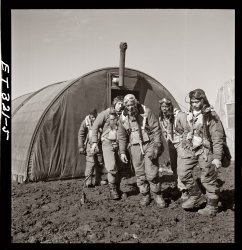
- Elsinore Tower: 1904
- Cincinnati circa 1904. "Elsinore Tower entrance, Eden Park." Valve house for the Cincinnati Water Works. 8x10 inch glass negative, Detroit Photographic Company. ... The mansion at the upper left was the Art Academy of the Cincinnati Art Museum . The building seen to its right is the west end of the ... Posted by Dave - 07/05/2019 - 4:22pm -
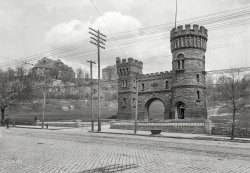
- Pittsburgh Rising: 1908
- ... State, built in 1890, traveled between Pittsburgh and Cincinnati. In 1913 she was converted into the an excursion boat and renamed ... Posted by Dave - 07/19/2012 - 10:20pm -
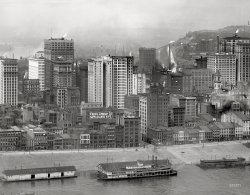
- Tremont Street: 1923
- ... my memory.
As a kid collecting baseball cards in Cincinnati I can remember when they moved to Milwaukee in 1953 and their home ... Posted by Dave - 07/17/2012 - 10:40pm -
![Tremont Street: 1923 Boston circa 1923. "Tremont Street and the Mall." One of the later entries in the Detroit Publishing catalog. Note the big Chevrolet sign. View full size.
Boston BravesSeeing the sign "Baseball Today at Braves Field" jogged my memory.
As a kid collecting baseball cards in Cincinnati I can remember when they moved to Milwaukee in 1953 and their home field was in County Stadium.
I also remember when they moved from Milwaukee to Atlanta.
Still recognizable todayProminent is Park Street Church. The two granite subway kiosks hide a mirror image pair. The visible ones were removed decades ago. Many of the buildings are still there but with extensive modernization. Ah, the 1920s, when women weren't afraid to show a little leg!
Packard & HudsonThe first two cars parked on the near side of the street are a circa 1919 Packard with a 1920-21 Hudson Touring Limousine behind.
+85Below is the same view from May of 2008.
1923 or 1928?I'm certainly no fashion expert, but something about the way the ladies are dressed says late Twenties.
[The rubber says Early to Mid Twenties. If it were 1928 the cars would have balloon tires. - Dave]
Ain't she sweet?The woman in light colored clothing is turning more heads than the photographer. No doubt her companion is equally well turned out but she is mostly obscured by the man who was walking between her and the photographer's lens at the moment the shutter was opened.
Fashion datingKnee length skirts didn't come along until 1925 - circa 1923 they were way longer.
Date of PhotoThe 1923 posted date could be valid. Except for the front car, all the other nearby cars are sporting a POV 1922 Massachusetts license plate. The front car (a Packard) looks to be a Taxi - therefore it could have a different plate.
Too early for neonIf that Chevrolet sign is neon, then 1923 would be almost certainly too early for this photo. Neon signs were only introduced to the US in 1923, and it's unlikely that Boston would have had one of the first in the country.
[It uses light bulbs. - tterrace]
Boston 1924This photo, dated 1924, does not show the Chevrolet sign (from a different angle, but for reference match the Coca-Cola sign to the Salada Tea sign in this photo.) Photos dated 1927 and later in that set do show the sign.
1928 without a doubtThe third car in, the one with the street sign in front of it is a 1928 Essex, the one in front of that a c.1921 Hudson, and the first car, the black one, is a 1926 or 1927 Packard. The The Essex and Packard DO have balloon tires. And no respectable women in Boston would have worn skirts so short prior to 1925.
Tremont St. Boston ca1923.The R.H. Stearns department store, right side of Tremont, stands today as elderly housing. Is the wireless antenna structure in the background on the building closer to us than the Tremont Theater (later Tremont Temple), on atop the Theater itself? TIA
It appears the Chevrolet sign is either atop the Tremont House hotel, or across Beacon St. on the building that was leveled in the 1970's for the 1 Beacon St. highrise, home of the Boston Gas Co. and an underground, 2-screen Sack's cinema. HTH.
(The Gallery, Boston, DPC)](https://www.shorpy.com/files/images/SHORPY_4a24958a.thumbnail.jpg)
- Traction Building: 1906
- Circa 1906. "Traction Building, Walnut and Fifth, Cincinnati, O." Nowadays known as the Tri-State Building. 8x10 inch glass ... bus overhead, 18" and 24"...
Double overhead AFAIK, Cincinnati and Havana were the only cities with double overhead for their ... Posted by Dave - 04/02/2015 - 9:18am -
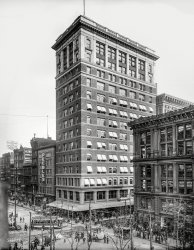
- Head Spotters: 1942
- February 1942. Cincinnati, Ohio. "Aluminum casting. The heads of these heat-treated pistons ... hardness reading.
(The Gallery, Alfred Palmer, Cincinnati Photos, Factories, WW2) ... Posted by Dave - 07/29/2012 - 2:40pm -
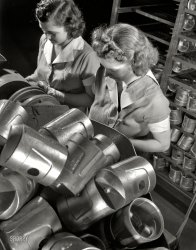
- Greyhound: 1938
- ... Saturday at the conclusion of a five-day tour from Cincinnati.
...
Over 300 of the new streamlined super-coaches are making ... Posted by Dave - 08/28/2012 - 1:40pm -
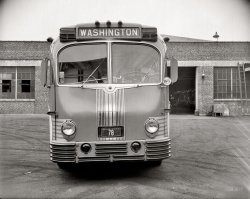
- Elm Street: 1905
- The Queen City circa 1905. "Elm Street, Cincinnati, Ohio." 8x10 inch dry plate glass negative, Detroit Publishing ... air conditioning. A check of my desk copy of the 1840 Cincinnati directory gave me Mr. Dress Maker Berger's address on Elm. Then ... where they have trolley buses.
Skip
(The Gallery, Cincinnati Photos, DPC, Horses, Streetcars) ... Posted by Dave - 08/08/2012 - 1:33pm -
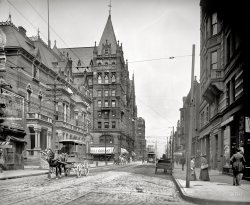
- Over and Under: 1938
- ... of Columbus, Ohio near the town of West Jefferson. The Cincinnati and Lake Erie interurban ran under the bridge parallel to Rt. 40 but ... on the other. The C&LE once raced an airplane from Cincinnati to Dayton as a promotional stunt and won.
Circleville, Ohio ... Posted by Dave - 01/07/2008 - 12:59am -
![Over and Under: 1938 Summer of 1938. "Underpass in central Ohio, Route 40. Roadside does not at first present a definite or meaningful picture. Closer investigation begins to reveal the character of the place." View full size. 35mm nitrate negative by Ben Shahn.
Underpass 'Character'Hmmm, the "character of the place" is not coming through to me. What am I not seeing?
C&O underpassPerhaps absence of graffiti gives it character....
The Low RoadThe entire passage, which was a general caption for 73 images taken along Route 40:
Roadside does not at first present a definite or meaningful picture. Closer investigation begins to reveal the character of the place. Majority of the farms are well-kept, occasionally divided by weed-grown and run-down farms. No apparent cause for this is in the character of the land. These farms are chief support of prosperous small towns in the vicinity.
Ohio is like thatRoute 40 hasn't changed much. It does go through Springfield, Columbus, and Zanesville, but other than that I would say he has described the "National Road" to a T.
Tough dividerI'd hate to ride the center line on that highway. That second underpass would be brutal.
Hobos?There appear to be people under the second overpass in the background, to the left.
[Weeds. - Dave]
C & O BridgeThe condition of the bridge I find striking. One never today sees a railway bridge freshly painted. This is in contrast to the unwashed tender.
Near West Jefferson, OhioI recognize the location of this photo. It was taken west of Columbus, Ohio near the town of West Jefferson. The Cincinnati and Lake Erie interurban ran under the bridge parallel to Rt. 40 but the track was gone. You can see how the bridge in the background is divided, originally the road went on one side and the C&LE on the other. The C&LE once raced an airplane from Cincinnati to Dayton as a promotional stunt and won.
Circleville, OhioThis photograph was taken of a C&O eastbound train near Circleville, Ohio. It not West Jefferson as the C&O did not go through there.
The route is US 23, now North Court Street. The tunnel was for the Scioto Valley Traction company.
Eric at CG Tower
(The Gallery, Ben Shahn, Railroads)](https://www.shorpy.com/files/images/8a18401u.thumbnail.jpg)
- The Mode: 1919
- ... dispensing water to travelers on the old C.H. and D.R.R [Cincinnati, Hamilton, & Dayton Railroad] back in 1873.
... Posted by Dave - 09/12/2011 - 11:21am -
![The Mode: 1919 Circa 1919, another Washington streetscape. "The Mode, 11th and F Streets." National Photo Company Collection glass negative. View full size.
Oh, that reminds me...I gotta pick up a couple of hat frames tomorrow.
Do you suppose ...that some of the ghosts in this picture would have been virtually invisible if they hadn't chosen to wear shoes that day?
Hatter and haberdasherNow what is the difference between a hatter and a haberdasher? I had always assumed they were the same.
[Hatters and milliners do hats; haberdashers do haberdashery -- men's clothing and accessories. - Dave]
Baked Possum TodayThe United Cafeteria opened in February 1919. The ad below is for one of their more exotic dinners. Based on other advertisements, the more typical fare included Roast Prime Ribs, Oyster Pot Pie, Chicken A La King, and Lobster a La Neuburg.
A Success From the Start
Washington during the past week has given cordial welcome to the United Cafeteria, 1008-1010 F street, opened a few days ago as the latest addition to the National Capital's already noteworthy assemblage of dining places. The new restaurant is unique in many of its features. A woman chef superintends the appetizing conceits that proceed from the kitchens to the display counters, patrons are taken care of at double capacity service stations and a stringed orchestra is regularly in attendance. A palm room is the novelty that occupies the basement floor.
Every appointment of the spacious dining rooms, from the immaculate linen to the generously filled platters, is suggestive of the refinements of service not ordinarily afforded by dining places of the popular, quick-lunch type. Courtesy, promptness and thoroughness of service, together with every excellence of cuisine, have united to command a patronage of over a thousand patrons at every meal. To Richard Neddo, president of United Cafeteria Company and owner of Hotel Neddo, of Norfolk Va., is accorded the praise for the enterprise that gives Washington this new and commodious and altogether desirable place to eat. It's the crowning achievement, by the way, in the career of a man who as a train boy received his first "service" lessons in dispensing water to travelers on the old C.H. and D.R.R [Cincinnati, Hamilton, & Dayton Railroad] back in 1873.
Washington Post, Feb 9, 1919
Boccioni Anyone?Look at the couple crossing the street and behold the vision that inspired the Futurist movement.
Still thereThe Mode is gone, but not the two fine red brick buildings behind it on 11th.
View Larger Map
Even back then...you couldn't find a parking space in D.C.
Possum PieI've heard possums described in many different ways, but "the sweetest morsel that can be set before man" is not one of them. I wonder how many hungry customers showed up that day?
Nice ridesA couple of expensive cars here -- can't identify the town car in the center, but the one with the light colored wheels to the left is a Pierce-Arrow.
Scarred and batteredThis building was sadly maimed before it was razed in the mid-90s - it's visible at far left here:
image from Flickr user Kinorama.
+90Below is the identical perspective taken in September of 2009. The Mode building was a pretty pathetic site in its last years on that corner.
(The Gallery, Cars, Trucks, Buses, D.C., Natl Photo, Stores & Markets)](https://www.shorpy.com/files/images/30396u.thumbnail.jpg)
- Comic Relief: 1922
- ... least to 1868.
[It's the Union Central building in Cincinnati. See Doug's comment above. - Dave]
I think the calendar on the ... is the Union Central / Central Trust / PNC building in Cincinnati.
http://en.wikipedia.org/wiki/PNC_Tower
(The Gallery, ... Posted by Dave - 02/02/2016 - 8:53pm -
![Comic Relief: 1922 February 11, 1922. Washington, D.C. "DeWitt Moore." Who can fill in the blanks? National Photo Company Collection glass negative. View full size.
It's the LotteryObviously the happy fellow won the lottery. His boss has just recieved his letter of resignation in the mail,and called him in to discuss it.
I don't know what's going on here.But that is one funny photo. I think we need to add a section where people can put text balloons over the people in the images to add what they think they might be saying.
Telegram"Yah suh, I predict in 2008 there is going to be a black President of the United States."
The PuzzlerLooks like you've got us good on this one, Dave. After downloading the largest tiff file of this image and squinting and grunting and fiddling with the brightness and contrast settings, I was able to make out only that the brass label on the happy man's cap reads "PORTER / [???] Savings Bank." Maybe "U.S. Savings Bank," but more likely not. And my favorite online search methods also goose-egged. The photo is great, and Concerned Citizens Would Like to Know. Hope somebody out there can enlighten us.
[The porter's cap says UNION SAVINGS BANK ("Oldest Savings Bank in Washington," at 710 14th Street NW) - Dave]
Questions of time and lightThe calendar on the right says "Union [General?] Life". But isn't that the Met Life Tower? Wikipedia claims the name "Metropolitan Life Insurance Company" goes back at least to 1868.
[It's the Union Central building in Cincinnati. See Doug's comment above. - Dave]
I think the calendar on the left is stuck on November 1921.
The light on the wall - what's the top half? Was it combined gas/electric? A gas fixture converted to electric?
And, Mr. Moore...regarding whatever terrific news you just got...CONGRATS!
WowNobody is touching this one!
Aha!I fussed around, reversing the image and playing with contrast and brightness. I think I can make out the message on that piece of paper.
DeWitt Moorebu De Woouten Send Dit?
(I trying but am DeWitt Mooreless.)
Hold Still!For Pete's sake, Rufus! Stop moving around, or I'll find somebody else with a lamp attached to his head!
Union CentralThe building on the calendar is the Union Central / Central Trust / PNC building in Cincinnati.
http://en.wikipedia.org/wiki/PNC_Tower
(The Gallery, D.C., Natl Photo, The Office)](https://www.shorpy.com/files/images/05757u.thumbnail.jpg)
- Home Office: 1935
- December 1935. "House in Cincinnati showing its conversion into businesses and blight." Photo by Carl ... customers like blight.
Actually Elmwood Place Not Cincinnati, but it's an easy enough mistake to make, since Elmwood Place and adjoining St. Bernard are both completely surrounded by Cincinnati. Anyway, here's the house below, with the dark and light chimney ... Posted by Dave - 07/17/2013 - 3:30pm -
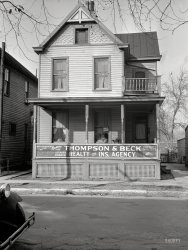
- Incline Saloon: 1907
- ... an awful lot, like a very lame roller coaster. Here in Cincinnati all the inclines but one maintained a constant grade. The one that ... Posted by Dave - 08/13/2012 - 6:45pm -
